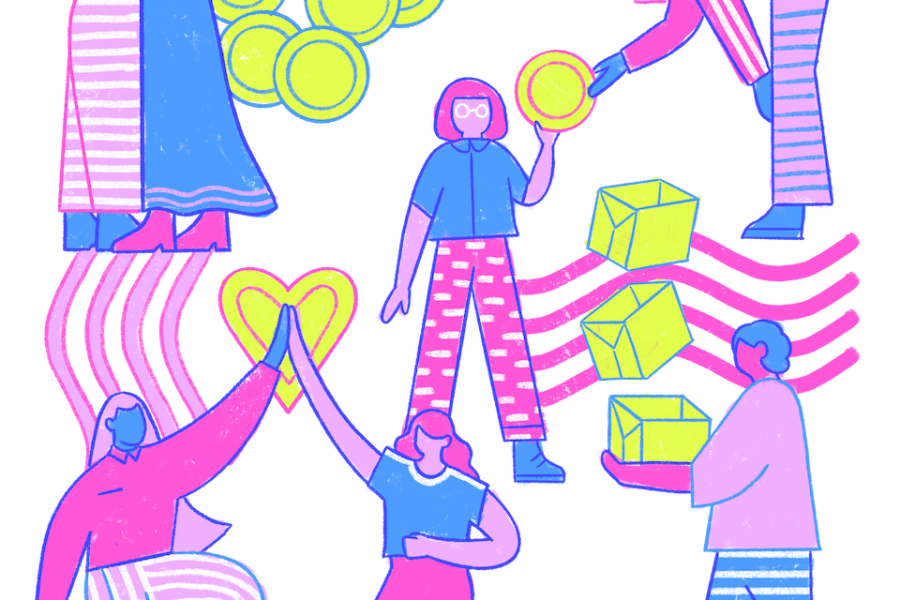ETH Portland kicked off its conference Oct. 28, 2021, showcasing the latest projects and startups within the blockchain communities and the development of what is known as web 3.0.
Blockchain technology and web 3.0 are still widely unknown, with many events and news within the community shared exclusively in hard-to-find digital spaces. Much of the technology that’s being developed is intended for future adoption—and much of the new framework being developed has years to go before it reaches everyday consumers. Whatever the future has in store for us, these companies are preparing for it and showcasing their findings at conferences like ETH.
The internet, as we all currently use it, is what’s described as web 2.0. In order to pull up a web page, a computer sends the data of that web page to your computer for you to browse, read, watch or play something. This computer is known as the server because it serves information to your personal computer or mobile device, known as the client.
When developers discuss web 3.0, they’re referencing the different framework for the internet that’s being constructed from the ground up. This framework decentralizes the traditional server—meaning there’s not one single computer that hands over a web page—creating an entire network of computers that give their own pieces of a page that is then reconstructed when it is sent to the user’s device.
Web 3.0 is also being constructed alongside concepts of the metaverse. Inside a typical website, text and images can be saved and displayed. These images are the same across all instances of the website. The metaverse adds an extra layer of depth to the internet, where web pages can become 3D spaces for users to interact in, and support digital assets like images that are exclusive to the user that owns it.
But why is this version of the internet being developed, and what does it mean for people who casually use the internet? Well, for right now, not much.
Web 3.0’s main goal is to build and normalize what are called “trust-less” and “permission-less” networks. This is simply a way for a website to be run without a governing body or third party. The idea is that each person who joins the network gets a vote. If millions of people join the network, every single person now has an equal vote on what could happen inside the webpage.
This would allow users to truly have a say inside the digital spaces they frequent in the future. The major concern is whether or not the collective can get there in the first place, especially when companies like Facebook—and parent company rebranded as Meta Platforms, Inc.—have no intention of loosening their grip on power.
This brings us to what is happening right now within the web 3.0 community. Interacting with these new kinds of networks requires special communication that simply hasn’t been developed yet. Much of it resembles the internet in the ‘90s, where all kinds of different individuals and companies were developing ways for computers to communicate with each other. Web 3.0 is so early in its infancy, individuals and companies alike are racing against the clock to develop these standards for computers to use in the upcoming era.
ETH Portland showcased a wide variety of protocols and tools being developed. While seeing the avant-garde technology being produced is exciting, there are some notable limitations for what can be done and what is planned as things are now. Some are dedicated to the true idealism behind blockchain and decentralized technology, while others seek to hinder the capabilities of internet users before they fully understand it.
For instance, look at Althea—one of the companies that showcased their products and current development. Althea is the first of its kind as a decentralized internet service provider, working with rural communities to give them fast internet at an affordable cost. Users of Althea pay for the electronic power, where the money maintains the network itself acting as an internet service provider. Imagine a scenario where Comcast isn’t the one who gets to delegate how internet service is provided and how much it costs, but everyone who uses Comcast is.
It’s a major breakthrough for marginalized communities within the U.S., where high-speed internet could be accessible anywhere for prices far below the average cost of cable internet—at the time of the conference, payments were roughly $16. The more users that join this network, the cheaper the bill becomes.
However, a major limitation is that this framework is still largely exclusive to developed countries. When asked about plans for globalized outreach—especially in places like South America where the internet is neither affordable nor accessible to the majority of the population—Althea struggles to find a way to make it low-cost in those areas. It’s a service with a lot of potential, but, ultimately, mirrors the pangs of a globalized economy. Accessibility and affordability is still heavily dependent on where you are born.
Mintgate was another company that showed an innovative project, building a digital platform that lets content creators have more autonomy and accessibility to share their digital works, such as NFTs. Their fundamental design was built for users who are not famous nor inherently well-known in any crypto or blockchain community.
While many companies build with intention to enable access, there was notable concern with at least one company’s model that sought to restrict access. Marketed as a “decentralized access control infrastructure designed to bring more utility to the web,” Lit Protocol allows individuals or companies to restrict access in different ways between the regular internet and web 3.0. An example was a Twitter post with a link, which prevented anyone from seeing and clicking the link unless they—quite literally—had enough cryptocurrency in their wallet. This protocol uses their own blockchain technology to make these kinds of restrictions largely unhackable or unalterable.
When asked if he found it inherently problematic that this technology could incentivize companies to make more exclusionary practices, co-founder David Sneider gave a telling response.
“Well, restricted access, in some ways, is simply part of the market economy,” Sneider said. Using AMC as an example, he explained that the tool allows for systems like a VIP ticket, where people can purchase a product and get exclusive access to content when the product is acquired. However, he failed to address the fact that everyone has access to the same menu of products, in his example. A tool like Lit Protocol allows anyone to restrict access to whomever they see fit—not just to the product, but the very menu of products itself.
“We’re at the low end of the system, so we have no say in what users do,” Sneider said. “We just provide the tools, letting users do with them as they see fit.”
Mark Zuckerberg had a very similar mindset when Facebook made its launch 10 years ago. It begs the question: If a tool has so much potential for misuse, why build it in the first place?






